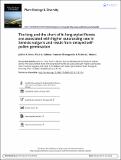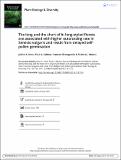Files in this item
The long and the short of it : long-styled florets are associated with higher outcrossing rate in Senecio vulgaris and result from delayed self-pollen germination
Item metadata
| dc.contributor.author | Irwin, Judith A | |
| dc.contributor.author | Ashton, Paul A | |
| dc.contributor.author | Bretagnolle, Francois | |
| dc.contributor.author | Abbott, Richard John | |
| dc.date.accessioned | 2016-06-02T10:30:11Z | |
| dc.date.available | 2016-06-02T10:30:11Z | |
| dc.date.issued | 2016 | |
| dc.identifier | 242202296 | |
| dc.identifier | f32e1330-862a-4ee2-a96b-6ac4bbeae0cb | |
| dc.identifier | 84969822808 | |
| dc.identifier | 000384307500004 | |
| dc.identifier.citation | Irwin , J A , Ashton , P A , Bretagnolle , F & Abbott , R J 2016 , ' The long and the short of it : long-styled florets are associated with higher outcrossing rate in Senecio vulgaris and result from delayed self-pollen germination ' , Plant Ecology & Diversity , vol. 9 , no. 2 , pp. 159-165 . https://doi.org/10.1080/17550874.2016.1181116 | en |
| dc.identifier.issn | 1755-0874 | |
| dc.identifier.uri | https://hdl.handle.net/10023/8916 | |
| dc.description | The research reported in this article was funded in part by the Natural Environment Research Council under grants: GR3/6203A - Male competition and outcrossing rate in a hermaphrodite plant. GR9/1782A – Genomic analysis of wild hybrid derivatives of Senecio squalidus x S. vulgaris using in situ hybridization. | en |
| dc.description.abstract | Background: It has been reported that some plants of the self-compatible species, Senecio vulgaris, produce capitula containing long-styled florets which fail to set seed when left to self-pollinate, although readily set seed when self-pollinated by hand. Aims: To determine if production of long-styled florets is associated with higher outcrossing rate in S. vulgaris, and whether long-styles occur in non-pollinated florets, whereas short-styles are present in self-pollinated florets. Methods: The frequency of long-styled florets was compared in the radiate and non-radiate variants of S. vulgaris, known to exhibit higher and lower outcrossing rates, respectively. In addition, style length was compared in emasculated florets that were either self-pollinated or left non-pollinated. Results: Long-styled florets were more frequent in the higher outcrossing radiate variant. Following emasculation, long styles occurred in non-pollinated florets, while short styles were present in self-pollinated florets. The two variants did not differ in style length within the non-pollinated or within the self-pollinated floret categories. Conclusions: A high frequency of long-styled florets is associated with higher outcrossing rate in S. vulgaris and results from delayed self-pollination and pollen germination on stigmas. | |
| dc.format.extent | 7 | |
| dc.format.extent | 488727 | |
| dc.format.extent | 595241 | |
| dc.language.iso | eng | |
| dc.relation.ispartof | Plant Ecology & Diversity | en |
| dc.subject | Asteraceae | en |
| dc.subject | Outcrossing rate | en |
| dc.subject | Pollination | en |
| dc.subject | Pollen germination | en |
| dc.subject | Ray and disc florets | en |
| dc.subject | Selfing | en |
| dc.subject | Senecio | en |
| dc.subject | Style length | en |
| dc.subject | GE Environmental Sciences | en |
| dc.subject | QH301 Biology | en |
| dc.subject.lcc | GE | en |
| dc.subject.lcc | QH301 | en |
| dc.title | The long and the short of it : long-styled florets are associated with higher outcrossing rate in Senecio vulgaris and result from delayed self-pollen germination | en |
| dc.type | Journal article | en |
| dc.contributor.institution | University of St Andrews. School of Biology | en |
| dc.contributor.institution | University of St Andrews. Scottish Oceans Institute | en |
| dc.contributor.institution | University of St Andrews. St Andrews Sustainability Institute | en |
| dc.identifier.doi | https://doi.org/10.1080/17550874.2016.1181116 | |
| dc.description.status | Peer reviewed | en |
This item appears in the following Collection(s)
Items in the St Andrews Research Repository are protected by copyright, with all rights reserved, unless otherwise indicated.


